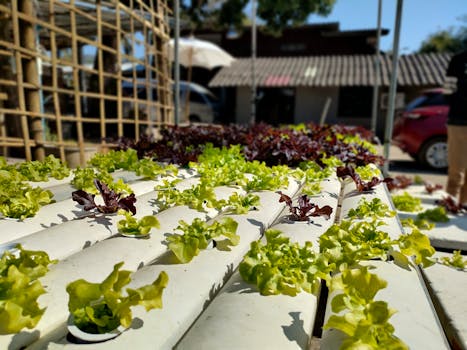Anunțuri
Înțelegerea designului agricol este crucială pentru promovarea practicilor durabile și satisfacerea cererii globale de alimente. Un design agricol bun combină eficiența, inovația și responsabilitatea față de mediu.
Proiectarea agricolă implică o combinație de arhitectură, inginerie și gestionare a terenurilor pentru a crea sisteme agricole productive. Această integrare sporește funcționalitatea și sustenabilitatea producției alimentare.
Pe măsură ce tot mai mulți oameni recunosc importanța agriculturii în viața de zi cu zi, înțelegerea principiilor sale de proiectare devine esențială. Acest articol va explora diverse fațete ale designului agricol și semnificația sa în practica contemporană.
Bazele designului agricol
Proiectarea agricolă se concentrează pe planificarea și organizarea operațiunilor agricole. Aceasta cuprinde planificarea spațiului, gestionarea resurselor și luarea în considerare a ecosistemului. Înțelegerea acestor elemente de bază este esențială pentru succes.
Proiectarea agricolă eficientă ia în considerare clima, tipurile de sol și disponibilitatea apei. Aceasta aliniază configurația fizică cu condițiile de mediu pentru a maximiza randamentele culturilor, reducând în același timp risipa de resurse.
Anunțuri
Mai mult, un design bun promovează economiile circulare prin integrarea produselor reziduale în sistemul agricol. Accentul pus pe designuri formulate optim asigură sustenabilitatea și productivitatea în agricultură.
Fermierii pot beneficia semnificativ de tehnologie în designul agricol. Instrumente inovatoare precum dronele, senzorii și software-ul avansat îmbunătățesc precizia și eficiența în gestionarea fermelor.
În concluzie, înțelegerea principiilor fundamentale ale designului agricol permite o productivitate și o sustenabilitate sporite. Această înțelegere creează sisteme mai bune care deservesc economia și mediul înconjurător.
Anunțuri
Elemente cheie ale designului agriculturii durabile
Proiectarea agriculturii durabile este esențială pentru sănătatea mediului pe termen lung. Aceasta implică diverse elemente care funcționează armonios pentru a crea un ecosistem agricol echilibrat.
Rotația culturilor este un element primordial al designului sustenabil. Această practică ajută la menținerea fertilității solului și reduce dăunătorii, ducând la o producție agricolă mai sănătoasă.
Gestionarea irigațiilor este, de asemenea, crucială pentru proiectele sustenabile. Utilizarea eficientă a resurselor de apă previne risipa și asigură că culturile primesc o hidratare adecvată fără a supraexploata resursele locale.
Sănătatea solului este unul dintre fundamentele agriculturii durabile. Practici precum culturile de acoperire îmbunătățesc structura solului și sporesc materia organică, beneficiind ciclurile viitoare de plantare.
Implicarea comunității este esențială în proiectarea unei agriculturi durabile. Implicarea actorilor locali asigură perspective diverse, ducând la practici agricole mai acceptate și mai eficiente.
Tehnologie modernă în proiectarea agriculturii
Tehnologia modernă a revoluționat designul agricol, stimulând eficiența și sustenabilitatea. Instrumente precum analiza datelor, software-ul GIS și automatizarea deschid calea către soluții agricole mai inteligente.
Agricultura de precizie a câștigat teren datorită tehnologiei moderne. Utilizarea imaginilor din satelit și a datelor de la senzori permite fermierilor să ia decizii informate cu privire la alocarea resurselor.
Dronele agricole joacă un rol vital în proiectarea agricolă. Acestea ajută la monitorizarea sănătății culturilor, la supravegherea suprafețelor mari și la optimizarea distribuției resurselor, îmbunătățind managementul general al fermei.
Automatizarea este o altă componentă care remodelează designul agriculturii. Tehnologii precum recoltatoarele robotizate pot crește eficiența și reduce costurile cu forța de muncă, asigurând în același timp o productivitate constantă.
Per ansamblu, integrarea tehnologiei moderne în designul agricol sporește eficacitatea practicilor agricole. Aceasta duce la randamente mai mari și la rezultate îmbunătățite în materie de sustenabilitate pentru întregul sector.
Rolul Agroecologiei
Agroecologia pune accentul pe relația dintre agricultură și sistemele ecologice. Promovează practici agricole durabile prin integrarea principiilor ecologice în proiectarea agriculturii.
Diversitatea culturilor este un principiu cheie al agroecologiei. Plantarea diverselor specii sporește reziliența și reduce vulnerabilitatea la dăunători, boli și impactul climatic.
Metodele agroecologice implică adesea practici agricole organice. Reducerea dependenței de îngrășăminte sintetice și pesticide susține sănătatea solului și biodiversitatea.
Proiectarea sistemelor agroecologice se concentrează, de asemenea, pe îmbunătățirea ecosistemelor locale. Crearea de habitate pentru organismele benefice favorizează controlul natural al dăunătorilor și îmbunătățește productivitatea generală a fermei.
În cele din urmă, încorporarea principiilor agroecologice în designul agricol duce la sisteme alimentare sustenabile, rezistente și ecologice.
Proiectare pentru reziliență climatică
Reziliența la schimbările climatice este din ce în ce mai importantă în proiectarea agriculturii. Pe măsură ce schimbările climatice se intensifică, proiectarea fermelor care pot rezista la fenomene meteorologice extreme devine crucială pentru sustenabilitate.
O modalitate de a spori reziliența este prin diversificarea culturilor și a creșterii animalelor. O abordare variată reduce riscul de eșec total al culturilor în condiții adverse.
În plus, strategiile de gestionare a apei sunt esențiale pentru proiectele rezistente la schimbările climatice. Implementarea sistemelor de colectare a apei de ploaie poate ajuta fermierii să facă față modelelor imprevizibile de precipitații.
Practicile de conservare a solului joacă, de asemenea, un rol semnificativ. Menținerea integrității solului prin tehnici precum mulcirea și aratul redus sporește capacitatea acestuia de a absorbi apa și de a rezista la eroziune.
Prin prioritizarea rezilienței climatice în proiectarea agriculturii, fermierii sunt mai bine echipați pentru a face față condițiilor de mediu în schimbare, asigurând în același timp securitatea alimentară pentru generațiile viitoare.
Design agricol condus de comunitate
Proiectarea agricolă condusă de comunitate pune accentul pe implicarea locală în sistemele agricole. Implicarea comunităților locale în procesele de proiectare promovează incluziunea și receptivitatea la nevoile locale.
Abordările participative în proiectarea agricolă sporesc reziliența sistemelor alimentare. Implicarea comunității asigură că practicile sunt relevante din punct de vedere cultural și adecvate din punct de vedere ecologic.
Colaborarea între diferitele părți interesate este vitală pentru un design agricol durabil. Fermierii, administrațiile locale și ONG-urile pot lucra împreună pentru a implementa soluții eficiente adaptate contextelor locale.
Programele de educație și formare profesională din cadrul comunităților consolidează și mai mult designul agricol. Consolidarea capacității locale asigură faptul că toți participanții înțeleg practicile durabile și beneficiile acestora.
În cele din urmă, designul agricol condus de comunitate duce la o suveranitate alimentară sporită, permițând comunităților să mențină controlul asupra sistemelor și programelor lor alimentare.
Concluzie
Înțelegerea designului agriculturii este esențială pentru realizarea unor operațiuni agricole durabile și productive. Fiecare element contribuie la crearea unor sisteme alimentare reziliente, capabile să facă față provocărilor actuale și viitoare.
Prin practici sustenabile, tehnologie modernă, agroecologie și implicarea comunității, designul agricol poate îmbunătăți eficiența, protejând în același timp mediul înconjurător.
Pe măsură ce continuăm să ne adaptăm la circumstanțele în schimbare, concentrarea pe un design agricol inovator și incluziv va asigura securitatea alimentară pentru generațiile viitoare.
Abordând aceste domenii cheie, putem promova o nouă eră în agricultură care să promoveze sănătatea ecologică, echitatea socială și viabilitatea economică.
În concluzie, o înțelegere cuprinzătoare a designului agricol este vitală pentru toate părțile interesate din lanțul de producție alimentară. Aceasta pune bazele unui viitor durabil în agricultură.
| Element | Importanţă |
|---|---|
| Rotația culturilor | Menține fertilitatea solului și reduce dăunătorii. |
| Managementul irigațiilor | Previne risipa de apă, asigurând în același timp hidratarea culturilor. |
| Sănătatea solului | Îmbunătățește ciclurile viitoare de plantare și atenuează eroziunea. |
| Diversitatea culturilor | Îmbunătățește reziliența și reduce pierderile cauzate de eșecuri. |
| Implicarea în comunitate | Se asigură că practicile sunt relevante din punct de vedere cultural și acceptate. |
- Implementați practici sustenabile.
- Folosește tehnologia modernă pentru eficiență.
- Implicarea comunităților în proiectele agricole.
- Concentrare pe rezistența și adaptarea la schimbările climatice.
- Promovarea principiilor ecologice în sistemele agricole.



